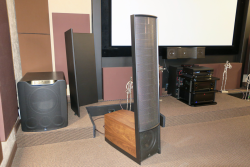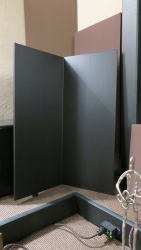More
- Preamp, Processor or Receiver
- Emotiva XMC-2
- Main Amp
- Emotiva XPA-5
- Additional Amp
- McCormack DNA-1 Custom Monoblocks (On Standby)
- Other Amp
- Woo Audio WA6se w/ Audeze LCD-2
- Universal / Blu-ray / CD Player
- Oppo BDP-95
- Front Speakers
- Revel Ultima Salon
- Center Channel Speaker
- Revel Voice
- Surround Speakers
- PSB Image B5
- Subwoofers
- Seaton Sound Submersive F2+/- pair
- Other Speakers or Equipment
- Cary SLP98P / VPI SuperScout with JMW9 & Hana MH
- Video Display Device
- LG 65" OLED 65CX
- Screen
- TBD
- Streaming Subscriptions
- JVC X70R Proj ; PS Audio PWD w/ Streaming Bridge
I just had to borrow this thread's title from the article written by J. Gordon Holt in March of 1994. It was too clever to pass up! But "space" on an AV forum doesn't refer to a vast void filled with stars; instead, it refers to the expanse of a recording space, concert hall, or other venue. It's the icing on the cake, but it can be spread thick or thin depending on the capabilities of the equipment, room, and source material.
The article begins by surmising that: "the ultimate soundstage is doomed to failure: we're trying to reproduce three-dimensional space from a two-dimensional system, and it simply can't be done." It goes on to present arguments for the spaciousness afforded by surround sound, spaciousness attributable to comb-filtering, and spacial differences between recording and reproduction rooms.
Now this is where the article takes an interesting turn, and the author's intention to support a migration from 2-channel to multi-channel music listening. He claims that the two configurations actually call for different speaker types: editorialized for 2-channel, and accurate for multi-channel. In conjuction with room treatment to acoustically isolate multiple channels, the speaker/room system then allows all manner of spatial information to shine forth, including height and depth.
Mr. Holt urges: If you're skeptical that spatial information is largely a product of system and speaker type, then listen to a large-scale work with bass in mono.
To what extent do you agree or disagree and why?
The article begins by surmising that: "the ultimate soundstage is doomed to failure: we're trying to reproduce three-dimensional space from a two-dimensional system, and it simply can't be done." It goes on to present arguments for the spaciousness afforded by surround sound, spaciousness attributable to comb-filtering, and spacial differences between recording and reproduction rooms.
Now this is where the article takes an interesting turn, and the author's intention to support a migration from 2-channel to multi-channel music listening. He claims that the two configurations actually call for different speaker types: editorialized for 2-channel, and accurate for multi-channel. In conjuction with room treatment to acoustically isolate multiple channels, the speaker/room system then allows all manner of spatial information to shine forth, including height and depth.
Mr. Holt urges: If you're skeptical that spatial information is largely a product of system and speaker type, then listen to a large-scale work with bass in mono.
"The first thing you'll notice, of course, is that the soundstage has collapsed. The second thing you'll notice is how much thinner the sound has become. Much of the upper bass/lower-midrange warmth and richness are gone, and the sound seems almost pinched in comparison to the stereo reproduction.
Psychoacousticians seem unable to explain why this is so. The consensus appears to be that the phenomenon is related to auditory masking---the tendency for sounds to obscure softer sounds of similar frequency coming from the same perceived direction. In mono, all sounds come from the same direction, so the hall reverb, being softer than the direct sounds, is largely masked by them. In stereo, the instruments producing those reverberations are heard to image at specific locations across the soundstage, while the reverberant energy comes from two spatially separated sources, offsetting some of the masking effects of the direct sounds. The result is that the reverberant energy becomes more audible---it sounds louder, even though, as mentioned previously, frequency-response measurements will reveal no differences that could begin to account for the extent of the perceived difference."
Psychoacousticians seem unable to explain why this is so. The consensus appears to be that the phenomenon is related to auditory masking---the tendency for sounds to obscure softer sounds of similar frequency coming from the same perceived direction. In mono, all sounds come from the same direction, so the hall reverb, being softer than the direct sounds, is largely masked by them. In stereo, the instruments producing those reverberations are heard to image at specific locations across the soundstage, while the reverberant energy comes from two spatially separated sources, offsetting some of the masking effects of the direct sounds. The result is that the reverberant energy becomes more audible---it sounds louder, even though, as mentioned previously, frequency-response measurements will reveal no differences that could begin to account for the extent of the perceived difference."
To what extent do you agree or disagree and why?













